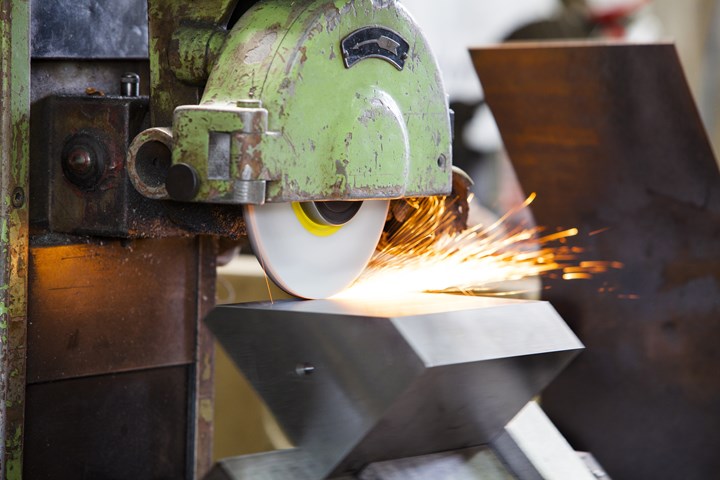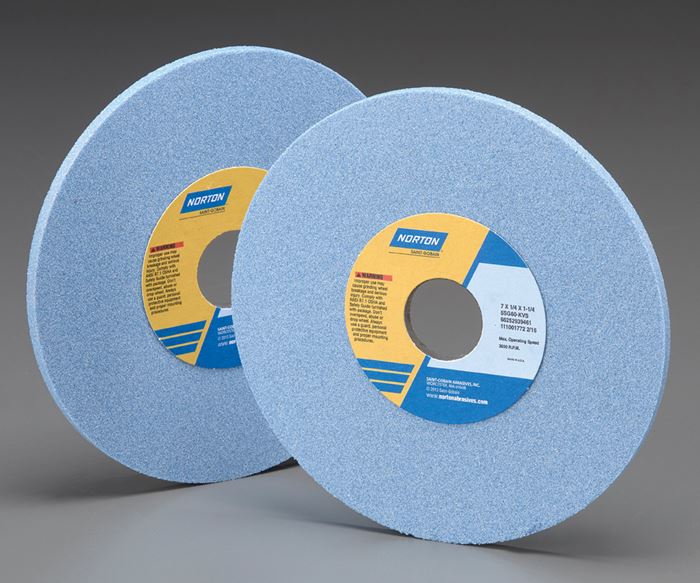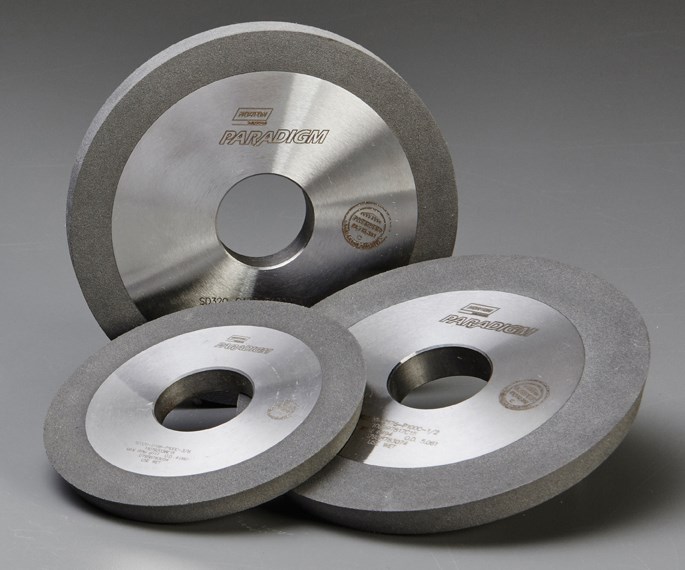Choosing The Right Grinding Wheel
Understanding grinding wheel fundamentals will help you choose the right wheel for the job.
Share





The grinding wheel is a cutting tool. It's an abrasive cutting tool.
In a grinding wheel, the abrasive performs the same function as the teeth in a saw. But unlike a saw, which has teeth only on its edge, the grinding wheel has abrasive grains distributed throughout the wheel. Thousands of these hard, tough grains move against the workpiece to cut away tiny chips of material.
Abrasive suppliers offer a wide array of products for a variety of grinding applications in metalworking. Choosing the wrong product can cost the shop time and money. This article presents some of the fundamentals of selecting the best grinding wheel for the job.
Abrasives — Grits and Grains
Grinding wheels and other bonded abrasives have two major components: the abrasive grains that do the actual cutting and the bond that holds the grains together and supports them while they cut. The percentages of grain and bond and their spacing in the wheel determine the wheel's structure.
The particular abrasive used in a wheel is chosen based on the way it will interact with the work material. The ideal abrasive has the ability to stay sharp with minimal point dulling. When dulling begins, the abrasive fractures, creating new cutting points.
Each abrasive type is unique with distinct properties for hardness, strength, fracture toughness and resistance to impact.
Aluminum oxide is the most common abrasive used in grinding wheels. It is usually the abrasive chosen for grinding carbon steel, alloy steel, high speed steel, annealed malleable iron, wrought iron as well as bronzes and similar metals. There are many different types of aluminum oxide abrasives, each specially made and blended for particular types of grinding jobs. Each abrasive type carries its own designation, usually a combination of a letter and a number. These designations vary by manufacturer.
Zirconia alumina is another family of abrasives, each one made from a different percentage of aluminum oxide and zirconium oxide. The combination results in a tough, durable abrasive that works well in rough grinding applications, such as cut-off operations, on a broad range of steels and steel alloys. As with aluminum oxide, there are several different types of zirconia alumina from which to choose.
Silicon carbide is an abrasive used for grinding gray iron, chilled iron, brass, soft bronze and aluminum, as well as stone, rubber and other nonferrous materials.
Ceramic aluminum oxide is another major development in abrasives. This is a high-purity grain manufactured in a gel sintering process. The result is an abrasive with the ability to fracture at a controlled rate at the submicron level, constantly creating thousands of new cutting points. This abrasive is exceptionally hard and strong. It is primarily used for precision grinding in demanding applications on steels and alloys that are the most difficult to grind. The abrasive is normally blended in various percentages with other abrasives to optimize its performance for different applications and materials.
Once the grain is known, the next question relates to grit size. Every grinding wheel has a number designating this characteristic. Grit size is the size of individual abrasive grains in the wheel. It corresponds to the number of openings per linear inch in the final screen size used to size the grain. In other words, higher numbers translate to smaller openings in the screen the grains pass through. Lower numbers (such as 10, 16 or 24) denote a wheel with coarse grain. The coarser the grain, the larger the size of the material removed. Coarse grains are used for rapid stock removal where finish is not important. Higher numbers (such as 70, 100 and 180) are fine grit wheels. They are suitable for imparting fine finishes, for small areas of contact and for use with hard, brittle materials.
Buying Bonds
To allow the abrasive in the wheel to cut efficiently, the wheel must contain the proper bond. The bond is the material that holds the abrasive grains together so they can cut effectively. The bond must also wear away as the abrasive grains wear and are expelled so new, sharp grains are exposed.
There are three principal types of bonds used in conventional grinding wheels. Each type is capable of giving distinct characteristics to the grinding action of the wheel. The type of bond selected depends on such factors as the wheel operating speed, the type of grinding operation, the precision required and the material to be ground.
Most grinding wheels are made with vitrified bonds, which consist of a mixture of carefully selected clays. At the high temperatures produced in the kilns where grinding wheels are made, the clays and the abrasive grain fuse into a molten glass condition. During cooling, the glass forms a span that attaches each grain to its neighbor and supports the grains while they grind.
Grinding wheels made with vitrified bonds are very rigid, strong and porous. They remove stock material at high rates and grind to precise requirements. They are not affected by water, acid, oils or variations in temperature.
Vitrified bonds are very hard, but at the same time, they are brittle like glass. These bonds are broken down by the pressure of grinding.
Some bonds are made of organic substances. These bonds soften under the heat of grinding. The most common organic bond type is the resinoid bond, which is made from synthetic resin. Wheels with resinoid bonds are good choices for applications that require rapid stock removal, as well as those where better finishes are needed. They are designed to operate at higher speeds, and they are often used for wheels in fabrication shops, foundries, billet shops and for saw sharpening and gumming.
Another type of organic bond is rubber. Wheels made with rubber bonds offer a smooth grinding action. Rubber bonds are often found in wheels used where a high quality of finish is required, such as ball bearing and roller bearing races. They are also frequently used for cut-off wheels where burr and burn must be held to a minimum.
The strength of a bond is designated in the grade of the grinding wheel. The bond is said to have a hard grade if the spans between each abrasive grain are very strong and retain the grains well against the grinding forces tending to pry them loose. A wheel is said to have a soft grade if only a small force is needed to release the grains. It is the relative amount of bond in the wheel that determines its grade or hardness.
Hard-grade wheels are used for longer wheel life, for jobs on high-horsepower machines and for jobs with small or narrow areas of contact. Soft grade wheels are used for rapid stock removal, for jobs with large areas of contact, and for hard materials such as tool steels and carbides.
Wheel Shapes
The wheel itself comes in a variety of shapes. The product typically pictured when one thinks of a grinding wheel is the straight wheel. The grinding face— the part of the wheel that addresses the work — is on the periphery of a straight wheel. A common variation of the straight wheel design is the recessed wheel, so called because the center of the wheel is recessed to allow it to fit on a machine spindle flange assembly.
On some wheels, the cutting face is on the side of the wheel. These wheels are usually named for their distinctive shapes, as in cylinder wheels, cup wheels and dish wheels. Sometimes bonded abrasive sections of various shapes are assembled to form a continuous or intermittent side grinding wheel. These products are called segments. Wheels with cutting faces on their sides are often used to grind the teeth of cutting tools and other hard-to-reach surfaces.
Mounted wheels are small grinding wheels with special shapes, such as cones or plugs, that are permanently mounted on a steel mandrel. They are used for a variety of off-hand and precision internal grinding jobs.
Tying It All Together
A number of factors must be considered in order to select the best grinding wheel for the job at hand. The first consideration is the material to be ground. This determines the kind of abrasive you will need in the wheel. For example, aluminum oxide or zirconia alumina should be used for grinding steels and steel alloys. For grinding cast iron, nonferrous metals and non-=metallic materials, select a silicon carbide abrasive.
Hard, brittle materials generally require a wheel with a fine grit size and a softer grade. Hard materials resist the penetration of abrasive grains and cause them to dull quickly. Therefore, the combination of finer grit and softer grade lets abrasive grains break away as they become dull, exposing fresh, sharp cutting points. On the other hand, wheels with the coarse grit and hard grade should be chosen for materials that are soft, ductile and easily penetrated.
The amount of stock to be removed is also a consideration. Coarser grits give rapid stock removal since they are capable of greater penetration and heavier cuts. However, if the work material is hard to penetrate, a slightly finer grit wheel will cut faster since there are more cutting points to do the work.
Wheels with vitrified bonds provide fast cutting. Resin, rubber or shellac bonds should be chosen if a smaller amount of stock is to be removed, or if the finish requirements are higher.
Another factor that affects the choice of wheel bond is the wheel speed in operation. Usually vitrified wheels are used at speeds less than 6,500 surface feet per minute. At higher speeds, the vitrified bond may break. Organic bond wheels are generally the choice between 6,500 and 9,500 surface feet per minute. Working at higher speeds usually requires specially designed wheels for high speed grinding.
In any case, do not exceed the safe operating speed shown on the wheel or its blotter. This might be specified in either rpm or sfm.
The next factor to consider is the area of grinding contact between the wheel and the workpiece. For a broad area of contact, use a wheel with coarser grit and softer grade. This ensures a free, cool cutting action under the heavier load imposed by the size of the surface to be ground. Smaller areas of grinding contact require wheels with finer grits and harder grades to withstand the greater unit pressure.
Next, consider the severity of the grinding action. This is defined as the pressure under which the grinding wheel and the workpiece are brought and held together. Some abrasives have been designed to withstand severe grinding conditions when grinding steel and steel alloys.
Grinding machine horsepower must also be considered. In general, harder grade wheels should be used on machines with higher horsepower. If horsepower is less than wheel diameter, a softer grade wheel should be used. If horsepower is greater than wheel diameter, choose a harder grade wheel.
More: 7 Key Factors in Choosing a Grinding Wheel
Care And Feeding
Grinding wheels must be handled, mounted and used with the right amount of precaution and protection.
They should always be stored so they are protected from banging and gouging. The storage room should not be subjected to extreme variations in temperature and humidity because these can damage the bonds in some wheels.
Immediately after unpacking, all new wheels should be closely inspected to be sure they have not been damaged in transit. All used wheels returned to the storage room should also be inspected.
Wheels should be handled carefully to avoid dropping and bumping, since this may lead to damage or cracks. Wheels should be carried to the job, not rolled. If the wheel is too heavy to be carried safely by hand, use a hand truck, wagon or forklift truck with cushioning provided to avoid damage.
Before mounting a vitrified wheel, ring test it as explained in the American National Standards Institute's B7.1 Safety Code for the Use, Care and Protection of Grinding Wheels. The ring test is designed to detect any cracks in a wheel. Never use a cracked wheel.
A wise precaution is to be sure the spindle rpm of the machine you're using doesn't exceed the maximum safe speed of the grinding wheel.
Always use a wheel with a center hole size that fits snugly yet freely on the spindle without forcing it. Never attempt to alter the center hole. Use a matched pair of clean, recessed flanges at least one-third the diameter of the wheel. Flange bearing surfaces must be flat and free of any burrs or dirt buildup.
Tighten the spindle nut only enough to hold the wheel firmly without over-tightening. If mounting a directional wheel, look for the arrow marked on the wheel itself and be sure it points in the direction of spindle rotation.
Always make sure that all wheel and machine guards are in place, and that all covers are tightly closed before operating the machine. After the wheel is securely mounted and the guards are in place, turn on the machine, step back out of the way and let it run for at least one minute at operating speed before starting to grind.
Grind only on the face of a straight wheel. Grind only on the side of a cylinder, cup or segment wheel. Make grinding contact gently, without bumping or gouging. Never force grinding so that the motor slows noticeably or the work gets hot. The machine ampmeter can be a good indicator of correct performance.
If a wheel breaks during use, make a careful inspection of the machine to be sure that protective hoods and guards have not been damaged. Also, check the flanges, spindle and mounting nuts to be sure they are not bent, sprung or otherwise damaged.
System Analysis
The grinding wheel is one component in an engineered system consisting of wheel, machine tool, work material and operational factors. Each factor affects all the others. Accordingly, the shop that wants to optimize grinding performance will choose the grinding wheel best suited to all of these other components of the process.
About the author: Joe Sullivan was a senior product manager for Norton Company, Worcester, Massachusetts.
Related Content
4 Rules for Running a Successful Machine Shop
Take time to optimize your shop’s structure to effectively meet demand while causing the least amount of stress in the shop.
Read MoreHow to Choose the Correct Measuring Tool for Any Application
There are many options to choose from when deciding on a dimensional measurement tool. Consider these application-based factors when selecting a measurement solution.
Read MoreWhat are Harmonics in Milling?
Milling-force harmonics always exist. Understanding the source of milling harmonics and their relationship to vibration can help improve parameter selection.
Read MoreRethink Quality Control to Increase Productivity, Decrease Scrap
Verifying parts is essential to documenting quality, and there are a few best practices that can make the quality control process more efficient.
Read MoreRead Next
Setting Up the Building Blocks for a Digital Factory
Woodward Inc. spent over a year developing an API to connect machines to its digital factory. Caron Engineering’s MiConnect has cut most of this process while also granting the shop greater access to machine information.
Read MoreRegistration Now Open for the Precision Machining Technology Show (PMTS) 2025
The precision machining industry’s premier event returns to Cleveland, OH, April 1-3.
Read MoreBuilding Out a Foundation for Student Machinists
Autodesk and Haas have teamed up to produce an introductory course for students that covers the basics of CAD, CAM and CNC while providing them with a portfolio part.
Read More
































